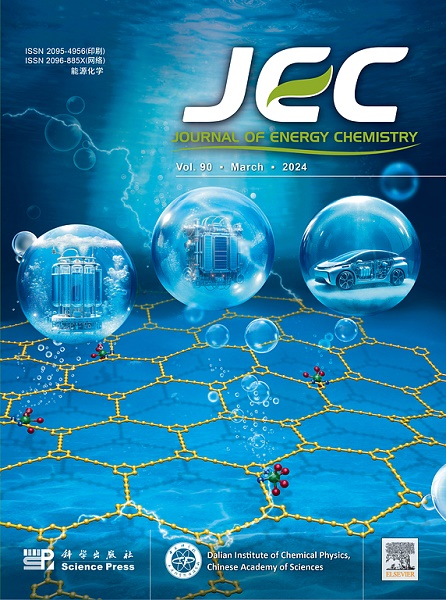In-situ formed LiAlO2 coating enabling the prelithiated SiOx@C anode with enhanced initial coulombic efficiency and electrochemistry-active solid-state interfaces
IF 13.1
1区 化学
Q1 Energy
引用次数: 0
Abstract
The prelithiated SiOx anode showcases markedly improved Li-storage capabilities compared to its unlithiated counterparts, yet it faces hurdles such as slurry gassing, electrolyte deterioration, and capacity fade attributed to residual alkali and an unstable electrolyte/anode interface. To tackle these challenges, we propose a strategic utilization of residual alkali by creating an in-situ γ-LiAlO2 functional layer on the prelithiated SiOx@C anode material. This is accomplished by incorporating a minor amount of Al2O3 into the SiOx@C/LiH precursor mixture before the solid-phase prelithiation process. The resulting modified prelithiated SiOx@C anode with in-situ formed electrolyte-isolating γ-LiAlO2 layer exhibits no discernible slurry gas generation within 7 days and substantially mitigates side reactions with the electrolyte, thereby boosting the initial coulombic efficiency and cycling stability of the SiOx@C anode. In half-cell evaluations, the prelithiated SiOx@C anode demonstrates a high Li-storage capacity of 1323 mAh g−1 and an impressive initial coulombic efficiency of 91.09%. When assessed in a 3.2 Ah 18,650 cylindrical battery, the prelithiated SiOx@C anode showcases exceptional cyclability, retaining 81% of its capacity after 1000 cycles, underscoring its potential for practical applications. This study introduces a scalable and cost-effective prelithiation technique that propels the development and practical deployment of Si-based anodes by resolving persistent scientific challenges with the use of inexpensive additives.

原位形成的LiAlO2涂层使预锂化SiOx@C阳极具有增强的初始库仑效率和电化学活性的固态界面
与未锂化的SiOx阳极相比,预锂化SiOx阳极的锂存储能力显著提高,但它面临着诸如浆液气化、电解质劣化、残碱和电解质/阳极界面不稳定导致的容量衰减等障碍。为了解决这些挑战,我们提出了通过在预锂化SiOx@C阳极材料上创建原位γ-LiAlO2功能层来战略性地利用残余碱的方法。这是通过在固相预锂化过程之前将少量Al2O3加入SiOx@C/LiH前驱体混合物中来实现的。通过原位形成的隔离电解质的γ-LiAlO2层修饰的预锂化SiOx@C阳极在7天内没有明显的浆液气生成,并且大大减轻了与电解质的副反应,从而提高了SiOx@C阳极的初始库仑效率和循环稳定性。在半电池评估中,预锂化SiOx@C阳极显示出1323 mAh g−1的高锂存储容量和令人印象深刻的91.09%的初始库仑效率。当在一个3.2 Ah的18650圆柱形电池中进行评估时,预锂化SiOx@C阳极显示出出色的可循环性,在1000次循环后仍能保持81%的容量,强调了其实际应用的潜力。本研究介绍了一种可扩展且具有成本效益的预锂化技术,通过使用廉价的添加剂解决持续存在的科学挑战,推动了硅基阳极的开发和实际应用。
本文章由计算机程序翻译,如有差异,请以英文原文为准。
求助全文
约1分钟内获得全文
求助全文
来源期刊

Journal of Energy Chemistry
CHEMISTRY, APPLIED-CHEMISTRY, PHYSICAL
CiteScore
19.10
自引率
8.40%
发文量
3631
审稿时长
15 days
期刊介绍:
The Journal of Energy Chemistry, the official publication of Science Press and the Dalian Institute of Chemical Physics, Chinese Academy of Sciences, serves as a platform for reporting creative research and innovative applications in energy chemistry. It mainly reports on creative researches and innovative applications of chemical conversions of fossil energy, carbon dioxide, electrochemical energy and hydrogen energy, as well as the conversions of biomass and solar energy related with chemical issues to promote academic exchanges in the field of energy chemistry and to accelerate the exploration, research and development of energy science and technologies.
This journal focuses on original research papers covering various topics within energy chemistry worldwide, including:
Optimized utilization of fossil energy
Hydrogen energy
Conversion and storage of electrochemical energy
Capture, storage, and chemical conversion of carbon dioxide
Materials and nanotechnologies for energy conversion and storage
Chemistry in biomass conversion
Chemistry in the utilization of solar energy
 求助内容:
求助内容: 应助结果提醒方式:
应助结果提醒方式:


